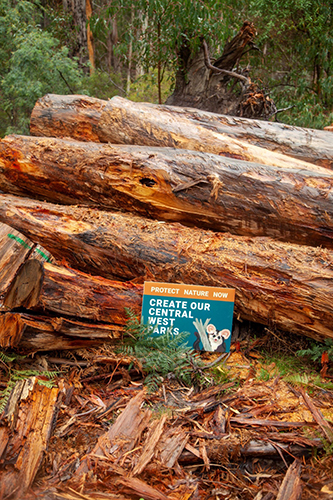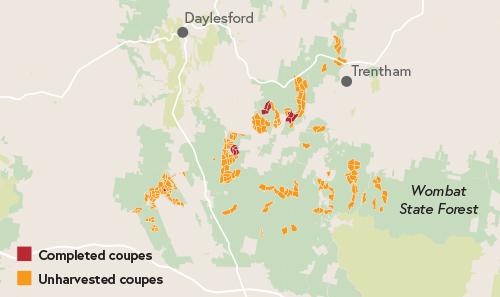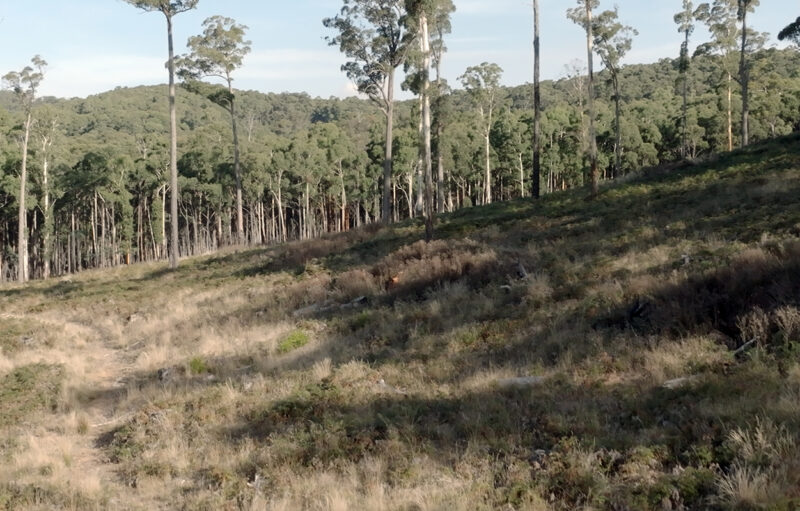PARK WATCH Article June 2023 |
Nature conservation campaigner Ben Gill reports that while all is quiet on the Wombat Forest front, rogue logging has shifted to the Cobaws.
The sounds of industrial logging have fallen quiet in the Wombat Forest in the last few months. Just one solitary machine is holding court on the log landing on Wombat Creek Road in Bullarto. Focus appears to have shifted to the nearby Cobaws in a sign that rogue logging using fire rules and exploiting loopholes to log Special Protection Zones (SPZs) and other protected areas is gaining traction.

The level of fine fuel strewn across the 80 hectare site in the Wombat exposes the fallacy of storm recovery works being conducted to minimise future fire risk. Areas of forest across the Victorian public estate that were once thought to have certain levels of protection are now finding themselves under attack from rogue logging conducted under the guise of fire mitigation. A recent update on VicForests website states:
Works in the Wombat State Forest commenced in May 2022, but were put on hold initially due to wet conditions and following that, species detections. We are currently awaiting advice from the Department of Energy, Environment and Climate Action (DEECA) before works can recommence.
The lack of adequate planning and proper management plans by VicForests played a part in its upcoming demise. Meanwhile another threat looms on the horizon, with a large scale operation undertaken by DEECA and Forest Fire Management Victoria (FFMV) that involves both roadside clearing and broadacre (large scale in deep forest) works.
Under the fire management rules, FFMV are only required to conduct a self-assessment and are not required to publicly release these documents.
Ongoing court cases against VicForests in the east are pushing bulldozers into the west to fulfil contractual obligations and timber shortfalls.
A recent Weekly Times article stated:
Harvest and haulage contractors said the thousands of fallen trees that litter the forest floor could have helped some of the state’s saw mills that faced shortages, and delivered royalty revenue to the Victorian Government.
VNPA have repeatedly requested meetings with FFMV in attempt to better understand and make a contribution to how these works are conducted. These requests have fallen on deaf ears. To date approx. 301 hectares has been harvested over 13 coupes across the Wombat (see map), a promised national and regional park.
Works continue in the Cobaw Ranges near Mount Macedon. This area is almost wholly covered by a Special Protection Zone (SPZ). The SPZ exists to safeguard this incredibly biodiversity haven that has become stranded in a sea of cleared farmland.
The Andrews Government committed to converting the forest to a conservation reserve based on the advice the Victorian Environmental Assessment Council.
Late last year, VNPA staff conducted extensive surveying after being alerted to potential broadacre operations. Our questions helped result in a down scaling to roadside works on five tracks. However, several weeks later a machine was found deep in the forest on a very inaccessible track in an area with almost non-existent storm damage. Two days after our concerns were raised, FFMV released a new map with this remote location on it. Our questions and concerns over these events are still with the Victorian Ombudsman.
Meanwhile, approximately 1,000 tree trunks await their fate in piles by the tracksides. Much of the work seem to focus on cherry-picking commercially viable windblown trees, rather than any attempt at clean-up of fine fuels.
Credible science consistently refutes these regimes of disturbance and forest fragmentation. Yet the desperate appetite of a dying industry is still devouring our natural world.
Current FFMV approaches appear to be deeply ingrained in departmental culture further fanning the flames of a divide between community.
Instead of scratching around in the forests for fallen trees to prop up a dying industry, we should be working towards a common goal.
Together we could both protect our living web of nature and mitigate fire threats by keeping moisture and structure in the forest, where it belongs.
Donate to help stop rogue logging
- Read the latest full edition of Park Watch magazine
- Subscribe to keep up-to-date about this and other nature issues in Victoria
- Become a member to receive Park Watch magazine in print

